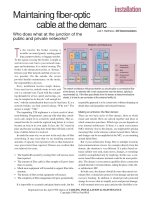Tài liệu Soneplex® PCS System Collocated in the BTS doc
Bạn đang xem bản rút gọn của tài liệu. Xem và tải ngay bản đầy đủ của tài liệu tại đây (96.87 KB, 4 trang )
Introduction
to PCS
Networking
Application Note 1219
Telecommunications
Soneplex
®
PCS System Collocated in the BTS
The Personal Communication Services (PCS) network is a digital network that has the
same basic components and standards as cellular networks. A PCS network consists of a
mobile switching center, base station transceivers or cell sites, and base station control-
lers connected to a network service provider.
The mobile switching center typically handles 100,000 subscribers. It connects the radio
network to the service provider’s telephone network. The base station controller handles
link handoffs, acts as an administrator for the location register and concentrates and
routes the traffic from several cell sites to the mobile switching center.
The cell site radio equipment requires one or two DS1 circuits connected to the local
exchange carrier’s network by optical fiber, T1 or High bit-rate Digital Subscriber Line
(HDSL). The cell site equipment is located in the last link of the PCS network and is
usually owned by the local exchange carrier (LEC).
Typical PCS Network
M1/3
Switch
Microwave
Radio
Microwave
Radio
Transport
Equipment
Transport
Equipment
Cell site radio
Equipment
Mobile Switching
Center
Base Station Controller
Base Transceiver Station
(Cell site)
Last Link
(T1, HDSL,Fiber)
Network Service Provider
(Local Exchange Carrier)
DSX-1
2
Soneplex
®
PCS Digital Transport Equipment Application Note 1219
Collocation of T1 transport equipment and customer demarcation point within the
base transceiver station (BTS)
The Soneplex PCS System, used in conjunction with the Soneplex Loop Extender
System or Soneplex Broadband System, is an inexpensive, flexible way of providing DS1
service delivery in the last link of a PCS network. The Soneplex Loop Extender chassis or
Soneplex Broadband chassis is located in the central office or remote terminal for
extension of DS1 circuits over copper or fiber facilities to the Soneplex PCS System
deployed in the Base Transceiver Station (BTS). In most applications, the network
provider will use existing outside plant cable facilities to extend the DS1 service to the
BTS.
Two questions arise when planning a PCS network:
1) What type of outside plant cable runs past the BTS, copper or fiber?
2) Where is the demarcation point, inside or outside the BTS?
Where the customer's demarcation point is located inside the BTS, the Soneplex PCS
System is an ideal solution. In this application (see figure 1), collocation is possible,
eliminating the need for a separate pedestal or outside plant cabinet to house the
transport equipment. The elimination of separate enclosures saves on valuable real-
estate and reduces the capital investment of the PCS network. In addition, the Soneplex
PCS System provides a single solution for DS1 services over copper or fiber. With other
systems, the network provider must install one product to extend optical DS2 (6.3 Mbps)
services over fiber to the BTS. And, the Soneplex PCS system's built-in intelligence
provides T1 circuit visibility for remote trouble sectionalization and identification. This
integrated intelligence reduces the need for a separate monitoring overlay system,
lowers overall technical dispatch expenses and improves the service provider's business
case.
Application
T1 Transport
Collocation
Figure 1
STS-1
X.25
SYSTEM MANAGEMENT
MODEM
LOCAL CRAFT PORT
DS3
OPTICAL
HDSL
T1
DS1
BTS
DS1
VOICE
RADIO
RACK
BTS
DS1
VOICE
RADIO
RACK
BTS
DS1
VOICE
RADIO
RACK
NETWORK TO
PCS PROVIDER
CENTRAL OFFICE OR
REMOTE TERMINAL
SONEPLEX
SYSTEM
SONEPLEX
SYSTEM
SONEPLEX
SYSTEM
SONEPLEX
SYSTEM
3
Soneplex
®
PCS Digital Transport Equipment Application Note 1219
Soneplex PCS Digital
Transport Equipment
Package
The Soneplex PCS System provides a flexible, low cost solution for T1 service delivery in
the last link of the wireless network. The system is completely modular and designed to
be space-efficient for both copper or fiber-based PCS applications. Each chassis is 1.75"
high (1 rack space) and fits into a 19-inch relay rack. The system can be preconfigured
for T1 transport over HDSL, T1 or Optical DS2 facilities or any combination. Modular
components, including a fiber splice tray, CSU panel and front access panel are also
available to custom design your own PCS system. All components are wired for -24 VDC
power (-48 VDC is also available).
Figure 2 shows a variety of applications using copper and fiber facilities to feed DS1's to
a cellsite where the customer demarc is collocated with the transport equipment.
The Federal Communications Commission auctioned 99 licenses for PCS, in 51 market
regions that covers the United States, its territories and protectorates. This action raised
$7 billion for the U.S. Treasury. The top three winners purchased 61 of the 99 licenses.
WirelessCo, a consortium of Sprint and three large cable TV companies bid $2.1 billion
for 29 licenses. AT&T Wireless PCS Inc. bid $1.7 billion for 21 licenses. PCS PRIMECO, a
consortium formed by Bell Atlantic, NYNEX, Pacific Telesis’ spin-off AirTouch Commu-
nications, and U S West bid $1.1 billion for 11 licenses. The PCS winners must provide
service coverage equal to 1/3 of the area population within five years. Coverage for the
other 2/3 must be provided within 10 years.
Figure 2
Soneplex PCS Transport System
HDSL
HDSL
Soneplex Broadband System
DS3
or
STS-1
HSW
APU
MPU
2B1Q
OSS
TL1
X.25
TBOS
CRAFT
INTERFACE
VTMM
or
DS3 MUX
WORKING/PROTECT
EC1M
DSX
HSP
TAU
MXW
MXP
DLX
ODS2 P
HLXC
ODS2 W
HLXC
Mid-Span
Repeater
RLX
Fiber splice
CSU CSU
H
L
X
D
S
X
Cell Site
Radio
Fiber splice
CSU CSU
H
L
X
D
S
X
Cell Site
Radio
Fiber splice
QLX
H
L
X
D
S
X
Cell Site
Radio
Fiber splice
CSU CSU
H
L
X
D
S
X
Cell Site
Radio
T1 SPAN
Line
Repeater
1219 4/97 Original © 1997 ADC Telecommunications, Inc. All Rights Reserved An Equal Opportunity Employer
Specifications published here are current as of the date of publication of this document. Because we are continuously improving our products,
ADC reserves the right to change specifications without prior notice. At any time, you may verify product specifications by contacting our
headquarters office in Minneapolis. ADC Telecommunications, Inc. views its patent portfolio as an important corporate asset and vigorously
enforces its patents. Products or features contained herein may be covered by one or more U.S. or foreign patents.
ADC Telecommunications, Inc.
4900 West 78th Street
Minneapolis, Minnesota 55435
FAX: (612) 946-3292
From North America, Call Toll Free: 1-800-366-3891
Outside of North America: 612-938-8080
Home Page Address:
International Sales Offices: Belgium 32-2-712-6500 • United Kingdom 44-734-441955
• Montreal, Quebec (514) 677-9166 • Vancouver, BC (604) 270-1675 • Toronto, Ont.
(905) 629-3104 • Ottawa, Ont. (613) 723-2171 • Singapore 65-225-8228 •Venezuela 58-
2-286-1444 • Mexico City, Mexico 525-658-4519 • Buenos Aires, Argentina (541) 449-
2669 • Sao Paulo, Brasil 55-11-3040-0666 • Sydney, Australia 61-2-9975-1499 •
Melbourne, Australia 61-3-9585-3931 • Beijing, China 86-10-6500-7001 • Dusseldorf,
Germany 49-211-370-350









